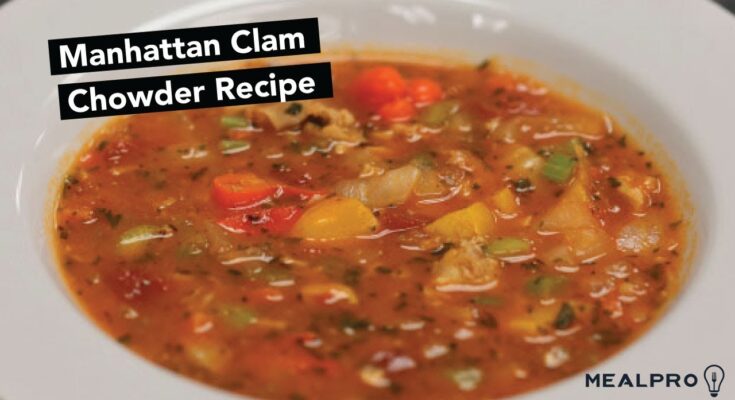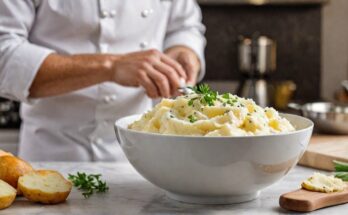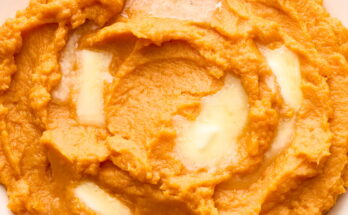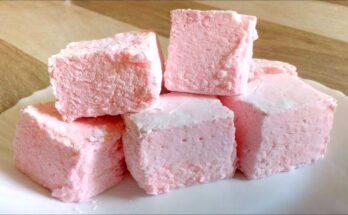Manhattan Clam Chowder Recipe: There’s something soul-soothing about a bowl of hot chowder, especially when it’s packed with the briny taste of the sea and vibrant vegetables. If you’ve ever wondered what makes Manhattan clam chowder a standout among seafood soups, you’re in for a flavorful ride. Unlike its cream-based cousin from New England, Manhattan clam chowder boasts a rich, tomato-based broth that’s both tangy and savory. This version is lighter but still hearty, making it perfect for year-round enjoyment.
What Makes It Different from New England Clam Chowder?
Let’s clear the air right away—no cream here. While New England clam chowder leans heavily on dairy for its thick texture, Manhattan clam chowder uses tomatoes to deliver its signature red hue and acidic punch. It’s a clash of coasts and culinary styles. Think of it like comparing a rich alfredo pasta to a light marinara—both delicious, just different moods. New England’s version is heavier and often served in colder months. Meanwhile, Manhattan’s is more like a stew, packed with vegetables like carrots, celery, and potatoes, and it’s perfect for any season.
A Brief History of Manhattan Clam Chowder
Despite the name, this chowder didn’t actually originate in Manhattan. The tomato-based version was likely popularized in the 1800s by Portuguese and Italian immigrants who brought their Mediterranean cooking style—using tomatoes instead of cream. Some New Englanders were so appalled by this tomato twist that a Maine legislator even attempted to ban the use of tomatoes in chowder in 1939! True story. Still, this zesty version gained popularity and earned the name “Manhattan Clam Chowder” thanks to its big-city boldness and melting-pot roots.
Ingredients Needed for Manhattan Clam Chowder
Making a great chowder starts with quality ingredients. Let’s break down what you need before diving into the kitchen.
Fresh vs. Canned Clams – Which One is Better?
This is the age-old kitchen debate. If you’ve got access to fresh clams—go for it. Fresh clams like littlenecks or cherrystones add an unbeatable sweetness and briny depth. But don’t sweat it if they’re not available. Canned clams are perfectly acceptable and can save you a lot of time. Just be sure to get the kind packed in juice, not oil or water. The juice adds a layer of seafood essence that’s essential to the broth. Pro tip: use the juice in the recipe for that extra kick of flavor.
The Role of Vegetables and Spices
Manhattan clam chowder is as much about the vegetables as it is the clams. The holy trinity? Onions, carrots, and celery. They form the flavor base. Add in potatoes for body, bell peppers for sweetness, and of course, crushed tomatoes for that rich red broth. Garlic, bay leaves, thyme, and parsley all add layers of complexity. Some cooks even toss in a pinch of red pepper flakes for a subtle heat.
Preparation Essentials
Before you start cooking, having the right tools and prep strategies can make your chowder come together seamlessly.
Kitchen Tools You’ll Need
No need for a gourmet kitchen here. Just grab the basics:
- Large heavy-bottomed pot or Dutch oven
- Cutting board and sharp knife
- Wooden spoon or spatula
- Ladle for serving
- Strainer (if using fresh clams)
- Measuring cups and spoons
These tools help with everything from sautéing vegetables to stirring the pot (literally).
Prepping the Ingredients for Maximum Flavor
This part’s crucial—don’t rush it. Dice your vegetables uniformly so they cook evenly. If you’re using fresh clams, scrub them well under cold water to remove sand and grit. Canned clams should be drained, but save that juice! As for the tomatoes, go for crushed or diced canned tomatoes for convenience. Add a dash of salt to the vegetables early in the sautéing process to draw out their moisture and concentrate their flavor.
Step-by-Step Instructions to Make Manhattan Clam Chowder
Time to get that pot simmering! Follow these steps, and you’ll end up with a restaurant-quality chowder right in your own kitchen.
Step 1 – Gathering and Prepping Ingredients
Start by assembling everything on your counter. Dice the onions, carrots, celery, potatoes, and bell peppers. Mince the garlic. Open the canned tomatoes and clams, separating the juice. This prep work sets you up for success—no scrambling mid-cooking.
Step 2 – Sautéing the Aromatics
Heat olive oil in your pot over medium heat. Toss in the onions, celery, and carrots. Cook for about 5-7 minutes, or until they begin to soften and release that mouth-watering aroma. Add in garlic and bell peppers, sauté for another 2 minutes. You’re building a flavor foundation here, so take your time.
Step 3 – Adding the Vegetables and Simmering
Next, pour in the clam juice, tomatoes, potatoes, and spices. Add bay leaves, thyme, and a little black pepper. Stir it all together and bring it to a boil. Once boiling, reduce the heat and let it simmer for 20-25 minutes. This allows the flavors to meld and the potatoes to soften.
Step 4 – Cooking the Clams
Now comes the seafood magic. If you’re using fresh clams, add them directly into the simmering soup. Cover the pot and let them cook for about 8–10 minutes or until the shells open up. Be sure to discard any that don’t open—those are no good. For canned clams, you’ll want to wait until the last few minutes of cooking to toss them in. Why? Because canned clams are already cooked, and overcooking them can make them chewy and tough. Stir them in gently, letting them warm through for just 2–3 minutes.
Step 5 – Final Touches and Serving
After the clams are in, taste the soup and adjust the seasoning. Maybe it needs a little more salt, a dash of pepper, or even a splash of clam juice to intensify the flavor. Turn off the heat and remove the bay leaves. Add freshly chopped parsley for a burst of color and freshness. Ladle your chowder into bowls and serve hot with a slice of crusty bread or oyster crackers. You’ve just made an authentic, mouthwatering Manhattan clam chowder from scratch!
Tips for the Best Flavor
Want to elevate your chowder from good to “Where’d you get this recipe?!” level? Here are some pro tips.
Balancing Acidity with Tomatoes
Tomatoes bring that tangy brightness, but too much can overpower the other flavors. If your chowder tastes too acidic, stir in a pinch of sugar—it’ll mellow it out. Another trick? Add a splash of clam juice or seafood stock to dilute and balance it. Taste as you go. The goal is harmony between the tomato base, the veggies, and the clams.
Enhancing Flavor with Seafood Stock
If you have the time, homemade seafood stock can take your chowder to another level. Simmer shrimp shells, fish bones, or clam shells with some onion, garlic, and herbs for about 30 minutes. Strain and use in place of water or store-bought broth. Even if you’re using canned clams, replacing water with seafood stock intensifies the oceanic flavor and makes the dish taste more robust and complex.
Common Mistakes to Avoid
Everyone’s messed up a soup before—don’t let it happen to your chowder.
Overcooking the Clams
This is a biggie. Clams are delicate, especially the canned ones. If you cook them too long, they turn into rubbery bits instead of tender seafood. Always add canned clams at the very end and let them heat through gently. Fresh clams only need a short steam in the broth to open up. Set a timer if you must!
Skipping the Simmering Time
Patience pays off. When you rush the simmering process, the vegetables don’t soften properly, and the flavors don’t have time to develop. Simmering for at least 20–30 minutes allows all the ingredients to marry together and create that deep, savory base that makes chowder so comforting.
Storing and Reheating Leftovers
Manhattan clam chowder is one of those dishes that often tastes even better the next day. But if you’re planning to make a big batch or simply can’t finish it all in one go, knowing how to store and reheat it properly is key to maintaining that just-cooked taste and texture.
Best Storage Practices
Let the chowder cool to room temperature before storing it. Don’t just toss a steaming hot pot into the fridge—that can lead to bacterial growth and uneven cooling. Once cooled, transfer the chowder into an airtight container. If stored properly in the refrigerator, it can last for up to 3–4 days. For longer storage, portion it into freezer-safe containers and freeze for up to 2 months.
Make sure you leave a little space at the top of your container when freezing—the liquid will expand. When you’re ready to enjoy it again, thaw it overnight in the refrigerator for the best results.
How to Reheat Without Losing Texture
To reheat, use the stovetop instead of the microwave if possible. Pour the chowder into a saucepan and warm it slowly over medium-low heat, stirring frequently. This method keeps the potatoes from turning mushy and prevents the clams from overcooking. If it thickens too much during storage, just add a splash of clam juice or broth to loosen it up. Avoid bringing it to a full boil—gentle heat is your best friend here.
Serving Suggestions
You’ve got your steaming bowl of chowder ready, but what should you serve it with to round out the meal? The right side dishes and beverages can make your chowder night feel like a gourmet seafood experience.
Ideal Side Dishes for Manhattan Clam Chowder
- Crusty Bread or Baguette: Perfect for dunking into the savory tomato broth.
- Oyster Crackers: A classic that adds just the right crunch.
- Garlic Bread: Adds a flavorful, buttery contrast to the tangy soup.
- Side Salad: A light mixed greens salad with vinaigrette balances the richness of the chowder.
- Grilled Corn on the Cob: Adds a sweet, smoky note that complements the chowder.
Wine and Beverage Pairings
Pairing the right drink with your Manhattan clam chowder enhances the experience:
- White Wines: A crisp Sauvignon Blanc or Pinot Grigio complements the briny clams and tomato broth.
- Light Beers: A pilsner or wheat beer pairs beautifully with the soup’s acidity and spice.
- Sparkling Water with Lemon: A non-alcoholic option that refreshes your palate between bites.
Health Benefits of Manhattan Clam Chowder
Beyond its bold flavor and comforting warmth, Manhattan clam chowder packs a surprising number of health perks. It’s a dish that not only tastes good but also does your body some favors.
Nutritional Value of Clams
Clams are a powerhouse of nutrients. They’re loaded with protein, iron, vitamin B12, and omega-3 fatty acids—all essential for maintaining energy levels, brain function, and heart health. Plus, they’re low in fat and calories, making them a lean source of seafood protein.
Low-Fat and Heart-Healthy Ingredients
Unlike cream-based chowders, the Manhattan version skips the heavy cream and butter, relying instead on a tomato base and olive oil. This makes it lower in saturated fat and calories. The inclusion of vegetables like carrots, celery, and bell peppers adds fiber, vitamins, and antioxidants. It’s a one-bowl wonder that satisfies without weighing you down.
FAQs about Manhattan Clam Chowder Recipe
1. Can I use frozen clams for this recipe?
Yes, frozen clams work great! Just thaw them thoroughly and drain before using. Be careful not to overcook them to avoid a rubbery texture.
2. Is Manhattan clam chowder gluten-free?
It can be! Just make sure the broth, clam juice, and canned tomatoes are gluten-free. Avoid adding flour or thickening agents unless labeled GF.
3. Can I make this recipe in a slow cooker?
Absolutely. Sauté the veggies first, then transfer everything except the clams to a slow cooker. Cook on low for 6–7 hours, adding clams in the last 30 minutes.
4. What’s a good substitute for clam juice?
You can use seafood or vegetable broth as a substitute. For added brininess, a splash of fish sauce works too—just go light with it.
5. How do I tone down the tomato flavor if it’s too strong?
Add a bit of sugar or a splash of broth to balance the acidity. You can also stir in a small spoonful of butter for added richness.
Conclusion
Whether you’re a lifelong seafood lover or just looking to try something new, Manhattan clam chowder is a dish worth adding to your recipe rotation. It’s hearty without being heavy, flavorful without being fussy, and customizable enough to make your own. With a tangy tomato base, tender clams, and a colorful medley of vegetables, each spoonful offers a warm hug for your taste buds. Follow this guide step by step, and you’ll not only cook a fantastic chowder—you’ll master it. Now grab that spoon and dig in!



